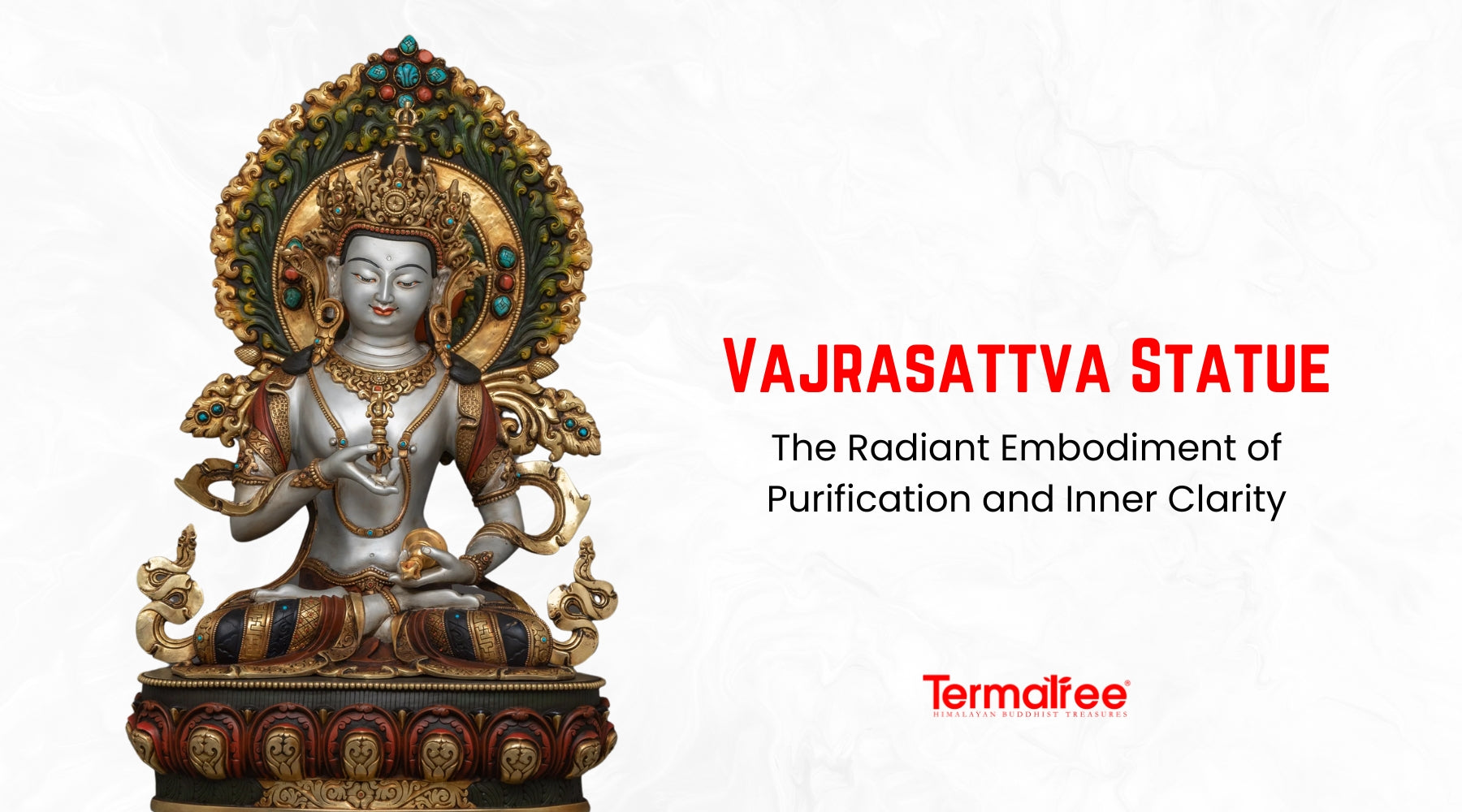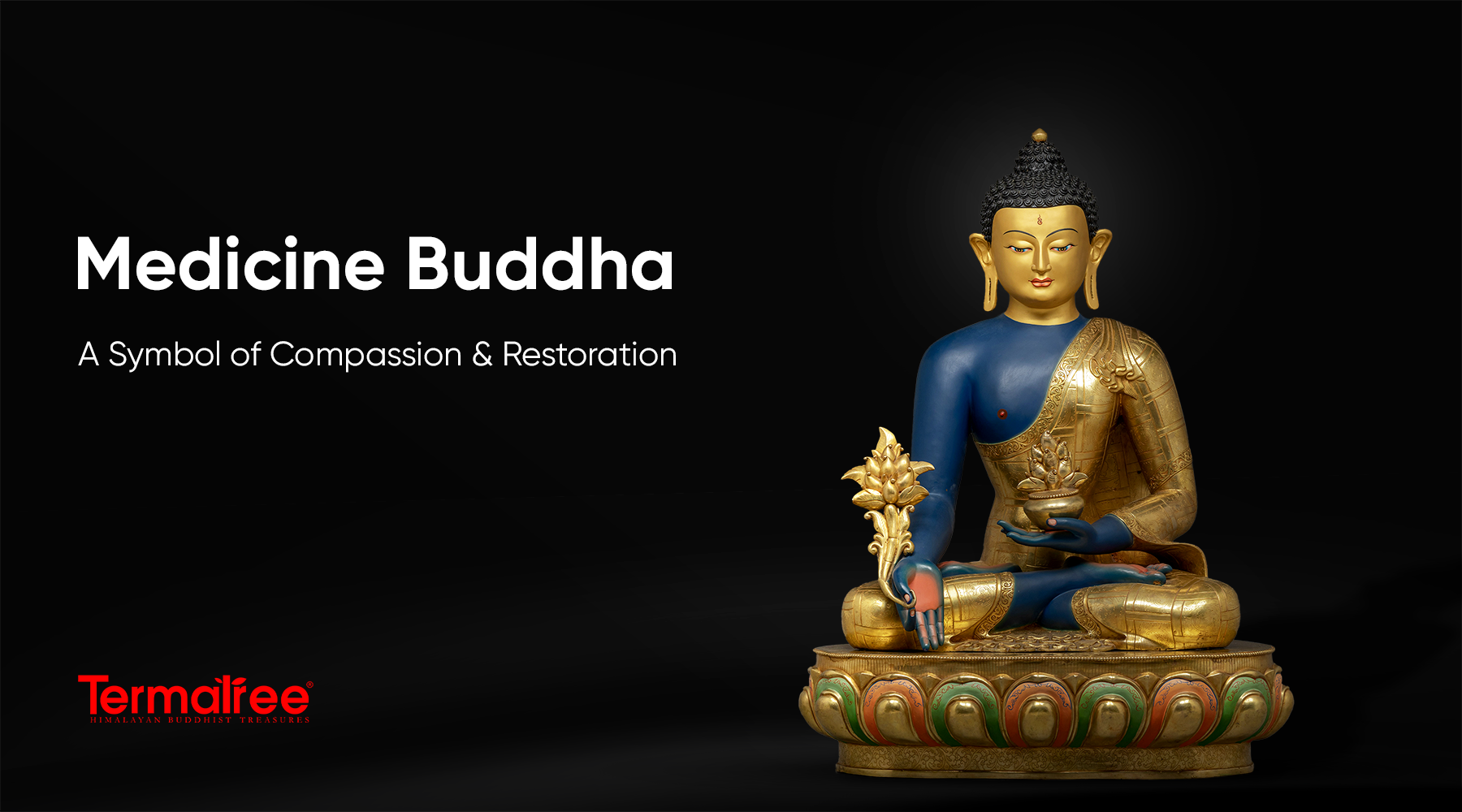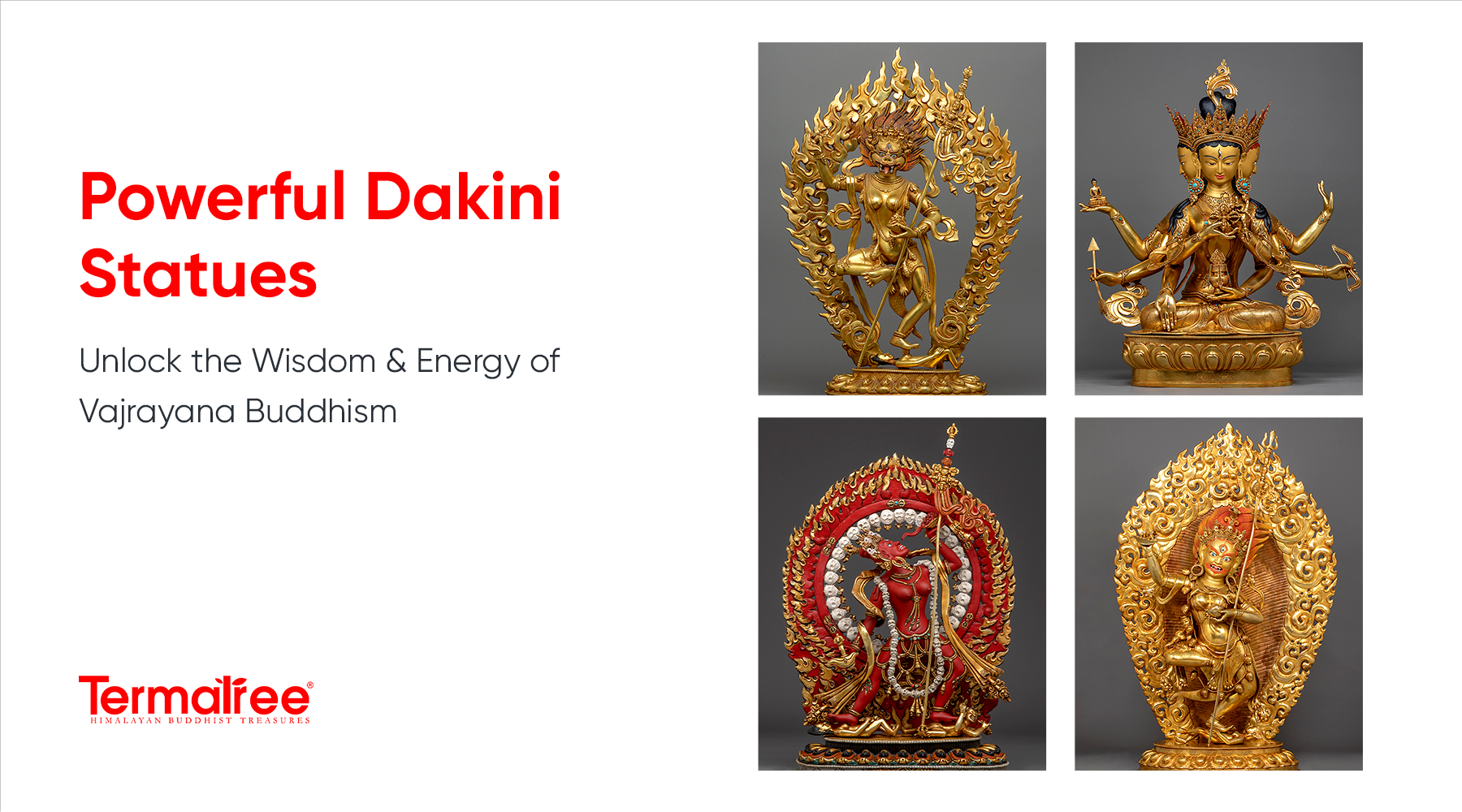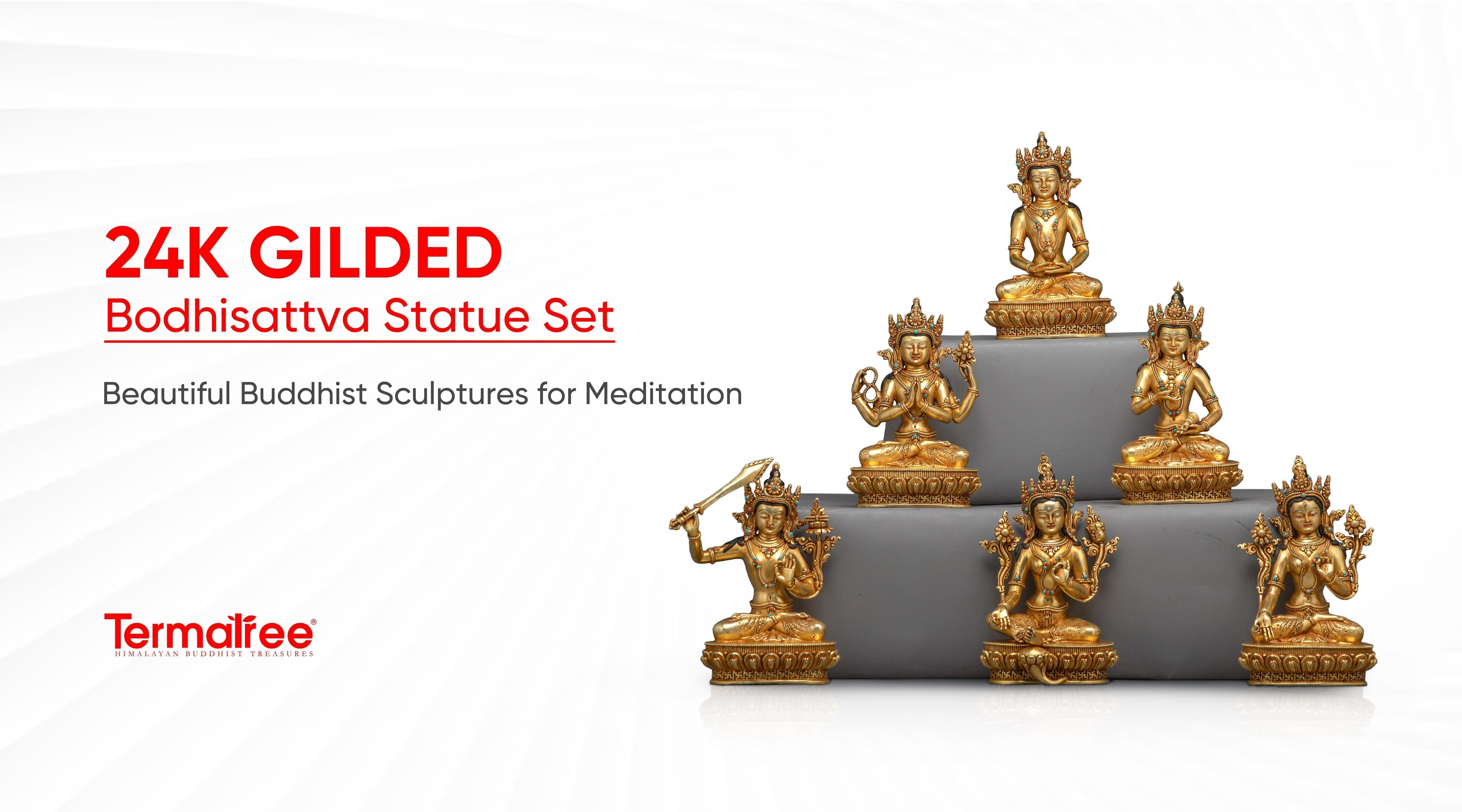Meet Vajrasattva, the Supreme Healer of the Mind
In the pure realm of Tibetan Buddhism, Vajrasattva is the purifying divine, the being who offers salvation from the tarnish of negative karma and obscuration, and the revered "Lord of Purification." He is not only the essence of purification; he is the pure process of purification itself. Through mantra, meditation, and sacred ritual, we can become a channel for the deep karmic purification and reawakening to our clear and radiant nature that he embodies.
This magnificent Vajrasattva Statue stands 17.7 inches tall (7.38 kg) and is a marvelous expression of devotion and craftsmanship. The artisans who crafted this statue created it with a copper body, elegantly finished with an oxidation patina, a luminous mercury gold gilding, decorated elegantly with acrylic accents, and enhanced with gemstones. The statue embodies Vajrasattva's compassion and determination, a high sacred aesthetic. Whether in a personal altar, temple shrine, or meditation room, the statue offers a refuge for qualities of inner peace, spiritual strength, and clarity in purification.
Craftsmanship Infused with Devotion

|
Size |
17.7”/45cm (Height) x 11.8”/30cm (Base) |
|
Weight |
7.38 kg |
|
Material |
Mercury Gold, Acrylic Paintings, Oxidized Copper Body, Handcarved Gemstones |
Every aspect of this statue exemplifies deep respect for both spiritual truth and artistic excellence. With a height of 17.7 inches (45 cm) and a base of 11.8 inches (30 cm), this energizing sculpture reflects the ancient sculpture traditions of the Himalayas. The copper body is covered in a deep oxidized patina, with mercury gold overlaid throughout the statue that reflects light from every angle and represents the brilliant transforming, purifying energy of Vajrasattva.
Every swipe of acrylic paint on his expression captures and creates both compassion and clarity in his gaze. The hand-carved gemstones inlaid into the statue are not merely decorative; they activate sacred geometry and channel devotional energy. This is not just a statue; this is a living generator of Vajrasattva's presence and was made to support the deepest degrees of tantric purification practice.
Iconography of Vajrasattva: Clarity in Form
Vajrasattva is depicted here in a seated 'vajra' (or lotus) posture, elegantly situated atop a double lotus pedestal. He emanates calm and stupendous spiritual power. With a gaze characterized by boundless compassion, it invites the practitioner to rest the mind in spacious awareness.
The Vajra in His Right Hand

Calmly held at heart level, the vajra symbolizes the indestructible nature of reality and represents method and compassionate action. The vajra symbolizes not only method and compassion but resides as a tool of spirituality - a cosmic tool that shatters delusion and confusion. This important implement emphasizes Vajrasattva's identity as the divine purifier in cutting through ignorance with clarity and the male aspect of enlightened activity.
The Bell in His Left Hand
The bell rests gently on the edge of his hip, representing ultimate wisdom and the emptiness of all phenomena. The bell, in Vajrayana iconography, is the female counterpart to the vajra and is always held in the left hand as a symbolic form of prajna, or transcendent wisdom. When the vajra and bell are held together, the vajra and bell represent the inseparable union of skillful means and wisdom, the two necessities for awakening.
Celestial Ornaments and Robes

Vajrasattva's divine aspect is further emphasized by ethereal silken robes that drape his torso and limbs. He wears many ornaments, including a sacred crown of five jeweled points, each representing a wisdom family, earrings, armlets, necklaces, and anklets. These ornaments represent the six paramitas—generosity, discipline, patience, diligence, concentration, and wisdom, representing the fully realized bodhisattva path. Every jewel within the adornments is rendered with careful detail to reinforce his transcendent beauty and state.
Serene Facial Expression

His face contains a deeply tranquil and compassionate expression, drawing the viewer into a contemplative state of calm. The slight smile and half-closed eyes suggest a state of internal stillness and meditative concern for the slightly perturbed nature of the ambivalence of being human, through the wit and wisdom of purity of mind, born of fearlessness in self awareness, inviting a differentiation between contemplation of the ferocity of attachment and beauty of loving kindness.
The Radiant Aureole
The beautiful aureole surrounding Vajrasattva shines with symbolic light and exquisite, ornate representations of scrolls with vines and lotuses, and brilliant designs that suggest the energy of presence and enlightenment not only floods outward from the deity, but also radiates on the practitioner, supporting a return of sacred vision.
Lotus Throne
Vajrasattva's crossed legs rest atop a double lotus base, which represents the realization of spiritual purity in conditions of samsara. The nether end of the lotus, despite muddy waters, which can affect what the lotus flower in this image represents, blooms in its state, untouched. The lotus throne petals deepen the details, suggesting the height of enlightenment, and that it is possible to develop one's own most realized state, free functioning of no duality and suffering, with dedication, availability, and trust.
Every aspect of Vajrasattva's iconography serves not only as a meditative object of support but also functions as sacred instruction, further leading us to clarity, spiritual awakening, and the realization of our mind's already pure nature.
The Sacred Role of Vajrasattva in Tibetan Buddhism
In Vajrayana Buddhism, Vajrasattva is the deity who is called upon to purify negative karma, obscurations, and transgressions of vows. Practitioners believe that through meditation on Vajrasattva and the recitation of his mantra, they can transmute karmic imprints and return to their true, original nature.
He is intimately associated with Samantabhadra, the primordial Buddha, and is seen as a sambhogakaya manifestation of that ultimate reality. Vajrasattva is also the central figure in many (preliminary Ngöndro practices) and particularly the practice of Hundred-Syllable Mantra, which is designed to purify obstructions and prepare the practitioner to engage with the deeper levels of tantric teachings.
As practitioners deepen their engagement through visualization and mantric recitation, Vajrasattva becomes a whole, living practice instead of just an object of devotion; he comes to symbolize the compassion that is inherent and latent in all beings to return to a state of purity and awareness.
The Power of Purification Practice
Vajrasattva's Hundred-Syllable Mantra is one of the most powerful, transformative practices in Vajrayana Buddhism, found in various Tibetan Buddhist lineages, especially in the Nyingma, Kagyu, and Gelug schools. This sadhana helps us purify the negative actions of the past and helps us clear the energetic blockages that have disrupted our spiritual progress towards enlightenment.
The Hundred-Syllable mantras practice often includes visualizing Vajrasattva in existence above our head, facing us, and as we recite each syllable of mantra, nectar from Vajrasattva's body pours homage over us, cleansing our subtle channels, body, speech and mind; until all karmic residues are verbally dissolved and only pure luminous awareness is generated.
Just repeating his shorter mantra even once a day can deeply transform our inner selves:
OM VAJRASATTVA HUM
We often say that the deep vibration from the symbolism in this mantra, in its bodyless form, resonates with the mindstream of Vajrasattva and transmits his blessings of purification immediately.
Vajrasattva's Inner Meaning: The Mirror of Your True Nature
At the core of Vajrasattva's representation is the acknowledgment of one's original purity. He is not distinct from us; he is simply a reflection or manifestation of what we all possess inherently, our own Buddha-nature. His whiteness, relaxed gaze, and even mudras indicate the vast potential in Buddhism in which each being can easily realize their own awakened mind.
He indicates that purity is not a Medication, but rather a remembrance and reclamation. The practice of Vajrasattva, rather, is an act of recollection or homecoming, back to the unfettered awareness that lies beneath the expansion of karma, not separate from it, and rather than disruptive conceptual thought.
His bell and vajra are not components of his form but invitations to balance method and wisdom, doing and knowing, effort and yielding. When contemplated thoroughly with sincerity, Vajrasattva assists the practitioner with clarity to cut through lies, purity of the past, and orient back toward luminous clarity.
Why This Vajrasattva Statue Belongs in Your Sacred Space
This is a unique handmade statue of Vajrasattva that will be a wonderful presence in the following contexts:
-
Advanced practitioners of Vajrayana who are engaged in ngöndro or purification sadhanas
-
Meditation rooms where clarity, stillness, and karmic release will be a primary focus
-
Temples or dharma centers representing practices focusing on Vajrasattva
-
Collectors of sacred Himalayan art focusing on high ritual functionality
The size, weight, and precision give it an impressive and commanding presence for daily ritual, short-term worship, or long-term worship. In formal shrines or personal retreat spaces, this figure serves as an energetic ally, a reminder of the possibility of transformation and awakening always being present.
Final Reflections: Vajrasattva as Inner Realization
Vajrasattva is a shining beacon of clarity, standing out amongst the confusion of emotional noise, karmic burdens, and countless other mental distractions. He does not come to us as an external saviour; Vajrasattva evokes inner transformation through disciplined practice of mantra, visualization, and commitment to purification. He is calmly urging us to remember the true purity that is the radiant mind, and that the purity of the mind was never lost; it was only forgotten.
This beautifully crafted sculpture captures more than just the form of Vajrasattva; it is capable of transmitting his resonance. It can become a spiritual tool, or rather an ethereal dharma gate in the form of physical material; it is always comforting to be able to engage within physicality when entering a meaningful, deeper role in our own reflections, karmic resolution, and awakened aspect of awareness.
May this Vajrasattva statue and symbol not only exist on your altar, but in the practice as a representation of our potential, a source of stillness, and as a reminder of the indestructible purity that is at the essence of an awakened mind.





1 comment
🔈 + 1.10789 BTC.NEXT - https://yandex.com/poll/enter/12JSER8t8KDJewYyTprg7K?hs=a4879da8b3d592f6e904f35094f1ea5a& 🔈
oyjhym